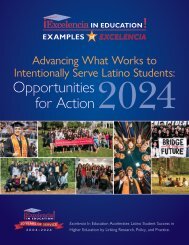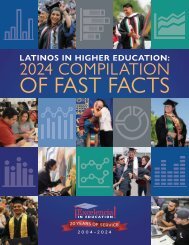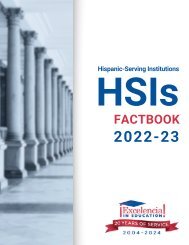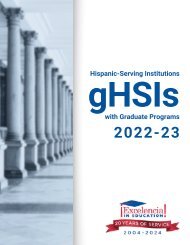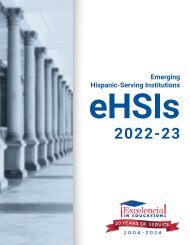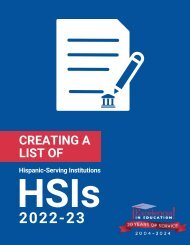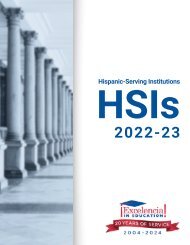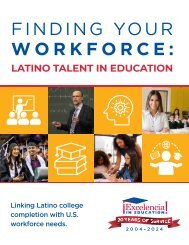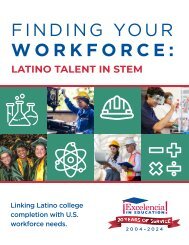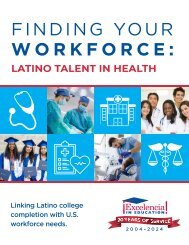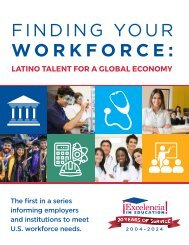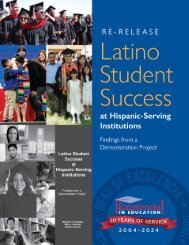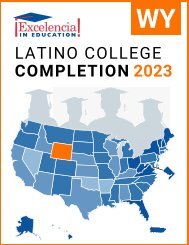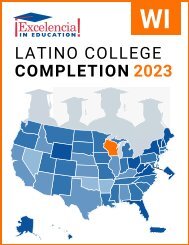Latino College Completion 2023: Alaska
Create successful ePaper yourself
Turn your PDF publications into a flip-book with our unique Google optimized e-Paper software.
AK
LATINO COLLEGE COMPLETION:<br />
ALASKA – <strong>2023</strong><br />
For the U.S. to regain the top ranking in the world for college degree<br />
attainment, <strong>Latino</strong>s will need to earn 6.2 million degrees by 2030. 1<br />
FAST FACTS<br />
STATE RANKING:<br />
<strong>Alaska</strong> had the 44th largest<br />
<strong>Latino</strong> population in the U.S.<br />
K-12 POPULATION:<br />
In <strong>Alaska</strong>, 10% of the K-12<br />
population was <strong>Latino</strong>. 2<br />
POPULATION:<br />
In <strong>Alaska</strong>, 7% of the population<br />
was <strong>Latino</strong>. 2<br />
MEDIAN AGE:<br />
The median age<br />
of Hispanics in<br />
<strong>Alaska</strong> was 27,<br />
compared to 40<br />
for White non-<br />
Hispanics. 2<br />
27<br />
Hispanics<br />
40<br />
White<br />
non-Hispanics<br />
ENROLLMENT:<br />
In <strong>Alaska</strong>, 13% of Hispanics<br />
(ages 18 to 34) were enrolled in<br />
higher education, compared to<br />
12% of White non-Hispanics. 2<br />
DEGREE ATTAINMENT:<br />
In <strong>Alaska</strong>, 32% of Hispanic adults<br />
(25 and older) had earned an associate<br />
degree or higher, compared to 48%<br />
of White non-Hispanic adults. 2<br />
Hispanic Adults = 3.2 of 10<br />
To reach the degree attainment goal by 2030, the U.S. can: close<br />
the degree completion gap by accelerating <strong>Latino</strong> completion while<br />
increasing for all students and scale up programs and initiatives that<br />
work for <strong>Latino</strong>, and all, students. The following demographics,<br />
institutional data, and practices inform <strong>Latino</strong> degree attainment.<br />
ENROLLING: Top 5 Institutions (Hispanic Undergraduates) in <strong>Alaska</strong>, 2021-22<br />
Institution<br />
Sector<br />
Grand<br />
Total<br />
NOTE: We use the terms <strong>Latino</strong> and Hispanic interchangeably in this factsheet.<br />
Hispanic<br />
Total<br />
Source: Excelencia in Education analysis using U.S. Department of Education, National Center for<br />
Education Statistics (NCES), Integrated Postsecondary Education Data System (IPEDS), 2021 Fall<br />
Enrollment, Graduation Rates Survey and Institutional Characteristics Survey.<br />
%<br />
Hispanic<br />
1 University of <strong>Alaska</strong> Anchorage Public, 4-year 7,284 729 10%<br />
2 University of <strong>Alaska</strong> Fairbanks Public, 4-year 4,108 353 9%<br />
3 University of <strong>Alaska</strong> Southeast Public, 4-year 999 80 8%<br />
Private not-forprofit,<br />
4-year<br />
4 <strong>Alaska</strong> Pacific University<br />
347 36 10%<br />
Private forprofit,<br />
2-year<br />
5 <strong>Alaska</strong> Career <strong>College</strong><br />
317 29 9%<br />
ASSOCIATE DEGREES: Top 5 Institutions Awarding to Hispanics in <strong>Alaska</strong>, 2020-21<br />
Institution<br />
Sector<br />
Grand<br />
Total<br />
Hispanic<br />
Total<br />
%<br />
Hispanic<br />
1 University of <strong>Alaska</strong> Anchorage Public, 4-year 665 53 8%<br />
2 University of <strong>Alaska</strong> Fairbanks Public, 4-year 254 23 9%<br />
3 University of <strong>Alaska</strong> Southeast Public, 4-year 77 7 9%<br />
Private forprofit,<br />
2-year<br />
4 <strong>Alaska</strong> Career <strong>College</strong><br />
29 4 14%<br />
5 – – – – –<br />
BACHELOR DEGREES: Top 5 Institutions Awarding to Hispanics in <strong>Alaska</strong>, 2020-21<br />
Institution<br />
Sector<br />
Grand<br />
Total<br />
Hispanic<br />
Total<br />
%<br />
Hispanic<br />
1 University of <strong>Alaska</strong> Anchorage Public, 4-year 1,039 96 9%<br />
2 University of <strong>Alaska</strong> Fairbanks Public, 4-year 558 52 9%<br />
3 University of <strong>Alaska</strong> Southeast Public, 4-year 144 10 7%<br />
Private not-forprofit,<br />
4-year<br />
4 <strong>Alaska</strong> Pacific University<br />
52 2 4%<br />
Private not-forprofit,<br />
4-year<br />
5 <strong>Alaska</strong> Bible <strong>College</strong><br />
4 1 25%<br />
White Adults = 4.8 of 10<br />
1 Projections to 2030: Excelencia in Education. (2020). Ensuring America’s Future: Benchmarking <strong>Latino</strong><br />
<strong>College</strong> <strong>Completion</strong> to 2030. Excelencia in Education. Washington, D.C.<br />
2 U.S. Census Bureau, 2021 American Community Survey 1-Year Estimates
<strong>Alaska</strong> Gap in Degree <strong>Completion</strong><br />
Closing the degree completion gap can be tracked<br />
by the 4 measures shown below. Alone, none<br />
of these measures capture the entire “story” of<br />
degree completion. However, in combination,<br />
they provide a useful picture of the gap in degree<br />
attainment between Hispanic and White non-<br />
Hispanic cohorts in a single year.<br />
Graduation Rate — Total percentage of students<br />
who graduated within 150% of normal time for<br />
first-time, full-time freshmen. This incorporates<br />
students that graduated in 3 years at two-year<br />
institutions, or in 6 years at four-year institutions.<br />
Transferred to Another Institution —<br />
Percentage of students that transferred to another<br />
institution and did not complete a degree.<br />
Still Enrolled — Percentage of students that are<br />
still enrolled at the point of 150% normal time to<br />
completion.<br />
No Longer Enrolled — Percentage of students<br />
that are no longer enrolled at the point of 150%<br />
normal time to completion.<br />
At two-year institutions, Hispanics’<br />
graduation rate was 4%-points<br />
lower than that of their White<br />
non-Hispanic peers in <strong>Alaska</strong>.<br />
TWO-YEAR INSTITUTIONS<br />
1%<br />
13%<br />
86%<br />
WHITE<br />
-4%<br />
18%<br />
82%<br />
HISPANIC<br />
DEGREE OUTCOMES<br />
■ No Longer Enrolled<br />
■ Still Enrolled<br />
■ Transferred to<br />
Another Institution<br />
■ Graduation Rate<br />
*Percentages may not add up to 100% due to rounding.<br />
At four-year institutions, Hispanics’<br />
graduation rate was 10%-points<br />
lower than that of their White<br />
non-Hispanic peers in <strong>Alaska</strong>.<br />
FOUR-YEAR INSTITUTIONS<br />
39% 40%<br />
4%<br />
18%<br />
39%<br />
WHITE<br />
-10%<br />
4%<br />
27%<br />
29%<br />
HISPANIC<br />
NOTE: Outcomes shown are for students at two-year institutions who started in Fall 2018, and<br />
for students at four-year institutions who started in Fall 2015.<br />
Source: Excelencia in Education analysis using the U.S. Department of Education, National<br />
Center for Education Statistics (NCES), Integrated Postsecondary Education Data System, 2021<br />
Graduation Rates Survey and the Institutional Characteristics Survey.<br />
Examples of What Works for <strong>Latino</strong> Students<br />
There are institutions showing success in enrolling, retaining, and graduating <strong>Latino</strong> students. The following are examples of<br />
programs across the country with evidence of effectiveness in serving <strong>Latino</strong> students nominated for Examples of Excelencia.<br />
The goal of the Engage. Develop. Grow. Empower. (EDGE) program<br />
at <strong>College</strong> of the Desert in California is to increase student success<br />
and mitigate achievement gaps in access, retention, persistence, and<br />
completion. EDGE provides students with a structured onboarding<br />
process, a summer bridge component to prepare for college and collegelevel<br />
coursework, comprehensive wrap-around support services, and<br />
financial support (plEDGE) for students’ first two-years of college. The<br />
program provides opportunities for students to connect with faculty,<br />
staff and other students before they start their academic journey. During<br />
the program, students participate in a rigorous review of subject-specific<br />
content in math and English, attend counseling sessions, learn about<br />
campus resources, attend special program presentations, and build lasting<br />
connections. The program also provides extensive outreach services in<br />
English and Spanish to our local high schools and the community at large<br />
to increase access and educational attainment within their service area.<br />
The EDGE/plEDGE Program serves 87% Hispanic/<strong>Latino</strong> students<br />
and they have higher persistence rates than Hispanic, non-program<br />
participants (89% to 73%, respectively). When comparing success rates<br />
in college level English, Hispanic/<strong>Latino</strong> EDGE students were more<br />
successful compared to their non-EDGE counterparts (66% vs. 54%,<br />
FA ‘18). EDGE/plEDGE students complete more units in their first<br />
semester (9.5) and first year (17.2) compared to their non-EDGE/<br />
plEDGE counterparts (7 units and 12, respectively). plEDGE students<br />
also have a higher 3-year completion rate (14%) compared to their<br />
non-plEDGE counterparts (9%).<br />
For more information on institutional programs improving <strong>Latino</strong> student success in higher education, access Excelencia in<br />
Education’s Growing What Works database at http://www.edexcelencia.org/growing-what-works<br />
ENSURING AMERICA’S FUTURE BY INCREASING LATINO COLLEGE COMPLETION • WWW.EDEXCELENCIA.ORG




